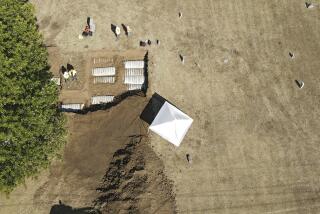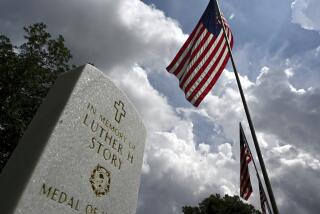Grave Tells of Union Soldier’s Final Hour : Archeology: Bones, artifacts taken from Antietam help scientists get a sense of one Union fighter, a casualty of the conflict’s bloodiest battle.
SHARPSBURG, Md. — In a moment of peace before the battle, the Union soldier must have looped his rosary around his neck.
Then three .58-caliber rounds pierced his chest, shattering his breastbone, and the New York Irishman fell to the ground, one of the 23,110 casualties of the Battle of Antietam.
His grave and those of three comrades were unearthed in 1988--126 years after the bloodiest day in U.S. military history--by Civil War buffs who had been looking for relics on private land within the battlefield boundaries.
For the last six years, archeologists and anthropologists have analyzed the four soldiers’ bones, dozens of artifacts and historical records to produce a rare glimpse into the last 45 minutes of one soldier’s life.
“So much is told from the perspective of the generals and officers,” said Stephen R. Potter, an archeologist with the National Park Service. “This personalizes the bloodiest day of American military history in the eyes of one man.”
Based on artifacts found in the graves, Potter determined that all were members of the 63rd New York Regiment, part of the famous Irish Brigade.
The identification process was narrowed further when an analysis of the bones showed that one of the men was 40 or older. (Most Civil War soldiers were in their late teens and 20s.) The other three were under 40.
Potter has deduced that the middle-aged soldier was either Pvt. James Gallagher, a stonecutter from Kilkenny, Ireland; Pvt. Martin McMahon, a laborer born in County Clare, Ireland; or Pvt. James McGarigan.
Potter believes that the private, whoever he was, probably took off his cap and placed the rosary about his neck after the brigade chaplain, Father William Corby, rode by shouting conditional absolution to those who were about to die.
As the Irish Brigade approached what would later be named Bloody Lane, a sunken road in the middle of the battlefield, a column of Confederates moved onto the crest of the plateau. The Irish Brigade had already suffered heavy losses, but continued to drive back the Confederates.
When the Irish Brigade reached the crest, the Confederates rose up and fired into the front rank. Potter believes that it was probably in this volley that the middle-aged Irishman was struck down.
According to historical accounts of the battle, at least eight color bearers of the Irish Brigade hit the ground, wounded or dead, after the first volley.
“I’m certain he was a member of the color guard,” Potter said. “If you are a member of the color guard, you are likely to be a target. He was no fool. He knew--to borrow a Southern phrase--he didn’t stand a dog’s chance in hell.”
The men died the day of the battle--Sept. 17, 1862--and were hastily buried under 20 inches of earth.
The soldiers rested there until 1988, when George Rees of Medina, Ohio, and two friends swept a field with metal detectors. Rees started digging and found a brass hook from a soldier’s pack, then ammunition, then buttons, and finally a tooth.
They took their findings to the landowner and later notified the National Park Service after they became uncomfortable about having disturbed a burial site.
Forensic scientists have had few opportunities to examine remains from Civil War burial sites, where the dead are usually allowed to rest in peace.
But these graves yielded 13 to 15 fragmented bones for each of the four men--compared with a total of 206 bones in a human skeleton--enough for Douglas Owsley, forensic anthropologist at the Smithsonian Institution’s National Museum of Natural History. He examined fingers, teeth, fragments of skull, shoulders, feet.
Later in 1988, the remains were reburied in a plain pine coffin at the National Cemetery at Antietam after a Mass at Bloody Lane.
Potter said the research showed that a handful of bones and artifacts can shed important light on the past--and the life of one Civil War victim.
“He didn’t live to tell his story,” Potter said. “I guess I felt it was my responsibility to tell his story.”
More to Read
Sign up for Essential California
The most important California stories and recommendations in your inbox every morning.
You may occasionally receive promotional content from the Los Angeles Times.










